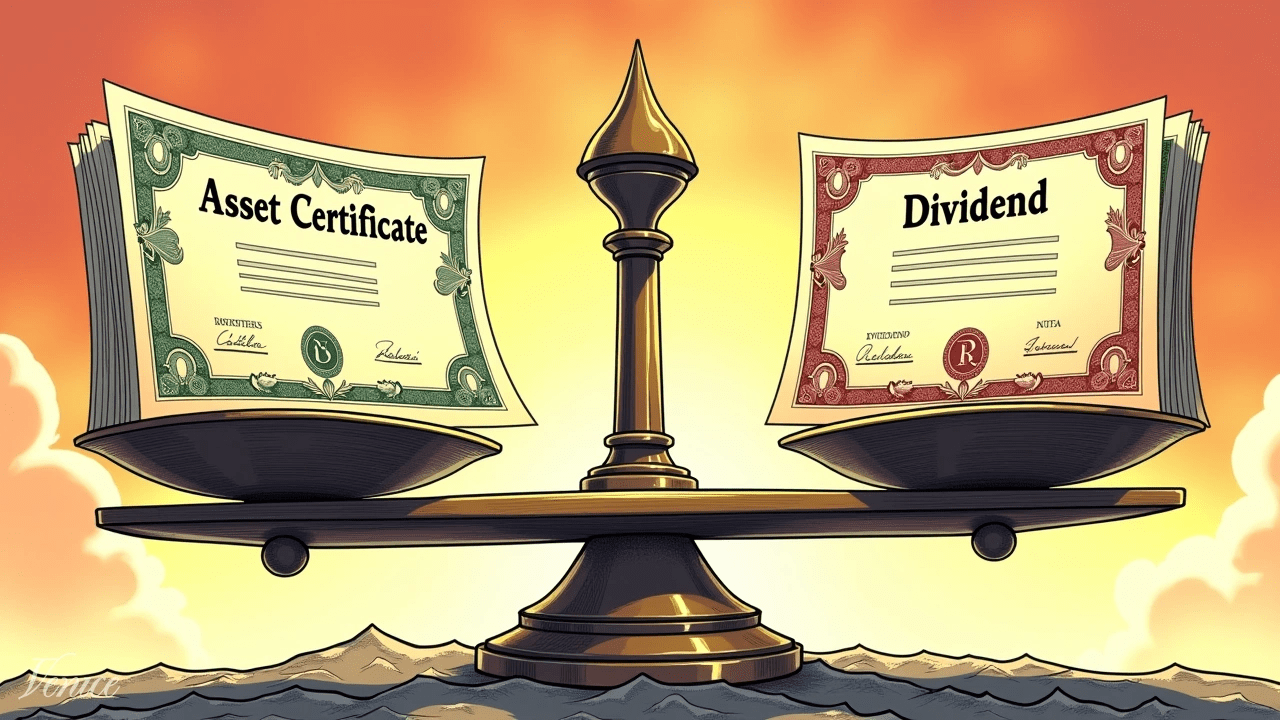The information provided in this article is for informational purposes only and should not be considered as investment or financial advice.
With the new Dividend and Asset Certificates from Permuto Capital trusts, a key question is how to value these certificates. Let’s look at one way to estimate a value for them, illustrating it with the announced trusts and potential future trusts. This exercise might also shed light on the value of this product, and why I think it’s a game changer that will attract significant interest.
The Model
(ValueAC)is the estimated value of an Asset Certificate(ValueDC)is the estimated value of a Dividend Certificate(S)is the current stock price(D0)is the current dividend(r)is the discount rate(g)is the growth rate of dividends
This model is based on the dividend discount model (DDM) with a constant-growth assumption, sometimes referred to as the Gordon growth model (GGM), adjusted for company specific data and risks.
The discount rate (r) can be found using various methods, but we will consider an adjusted Capital Asset Pricing Model (CAPM), which considers the risk-free rate, a DC’s beta, and a market risk premium.
(Rf)is the risk-free rate, e.g. the yield on 10-year U.S. Treasury note.(β)is a stock’s beta relative to the market, which captures how different a stock might move relative to the market based on specific risks.(β*)is the beta for a Dividend Certificate that can be adjusted downwards from(β)since the isolated dividend is likely less volatile than the stock.(Rm−Rf)is the market risk premium, which represents the return investors would expect from the stock market over the risk-free rate.
Assumptions
The model above and its application to various stocks below makes a number of assumptions. Specifically it assumes:
- Risk-free rate of 4%: This is based on the 10-year U.S. Treasury note yield at time of writing.
- Market risk premium of 5%: Based on “Historical – Multiple Equity Markets” ERP from “Equity Risk Premiums (ERP): Determinants, Estimation, and Implications – The 2025 Edition (March 05, 2025)” by Damodaran. Depending on the approach chosen, the market risk premium can range from 2.88% to 5.44%.
- DCs are held on Chia: The fee Permuto takes on dividend payouts varies depending on where the DC is held. For simplicity, we assume DCs are held on Chia for the lower fee and hence higher effective yield.
Furthermore, the model does not consider factors such as:
- Temporal changes: DC values could be higher leading up to the dividend payout, and lower immediately after, capturing the opportunity cost of locking up capital in the time period between payouts.
- Deposit and redemption fees: The Permuto trusts charge a 0.5% deposit fee and 1% redemption fee. Technically this puts a lower and upper bound on the price of a trust unit (AC+DC) between
(0.99 × S, 1.005 × S)due to arbitrage. This is ignored and the relationship ofValueAC = S - ValueDCis assumed. - Trust deposit limits: The pricing of trust units can also be affected if a Permuto trust hits its trust holding limit of outstanding shares (5% at time of writing) due to the inability to deposit new shares to arbitrage against the underlying share price.
- Tax implications: Tax treatment for each certificate can differ from holding underlying shares depending on the specific jurisdiction (e.g., capital gains tax, income tax), resulting in a trust unit valued more than the sum of its parts.
Applying the Model
To illustrate the application of this model, we will apply it to the three announced trusts:
- Microsoft (MSFT)
- Apple (AAPL)
- Broadcom (AVGO)
We will also consider two theoretical examples to illustrate how these certificates might be valued for two extreme cases.
- Nvidia (NVDA) – representing a stock with very low dividend
- Franklin Resources (BEN) – representing a stock with a very high dividend
Based on the stock prices at the time of writing, we will use the following prices for each stock (rounded for ease of calculation).
| Stock | Stock Price | Annual Dividend | Dividend Yield |
|---|---|---|---|
| Microsoft (MSFT) | $ 360 | $ 3.32 | 0.92% |
| Apple (AAPL) | $ 188 | $ 1.00 | 0.53% |
| Broadcom (AVGO) | $ 150 | $ 2.36 | 1.57% |
| Nvidia (NVDA) | $ 100 | $ 0.04 | 0.04% |
| Franklin Resources (BEN) | $ 17 | $ 1.28 | 7.53% |
Stock specific assumptions
For each stock, we need to estimate the dividend growth rate (g) and discount rate (r) as a function of each stock’s beta. These two variables are a reflection of the stock’s volatility and outlook on dividend changes.
Growth Rates
- 2% for MSFT, AAPL, AVGO, a conservative estimate for large cap tech companies with a steady history of dividend payments.
- 3% for NVDA, reflective of potential for higher future dividends.
- 1% for BEN, reflective of the more conservative finance industry.
DC Betas
Stock beta estimates are taken from Yahoo! Finance as of April 7, 2025. DC Betas are calculated by adjusting the 5-year monthly stock beta estimates downwards by 0.1. This results in the following estimates:
| Stock | Growth Rate | Stock Beta | DC Beta | Discount Rate |
|---|---|---|---|---|
| MSFT | 2% | 1 | 0.9 | 8.5% |
| AAPL | 2% | 1.26 | 1.16 | 9.8% |
| AVGO | 2% | 1.07 | 0.97 | 8.85% |
| NVDA | 3% | 1.96 | 1.86 | 13.3% |
| BEN | 1% | 1.39 | 1.29 | 10.45% |
Resulting Valuations
Applying the above estimates to the model, we get the estimates for the value of DC and ACs for each stock. We can also calculate an effective yield for the scenario where an investor deploys their capital entirely towards DCs, forgoing any asset pricing risk. Since each DC earns the full dividend of a full share, the effective yield is simply calculated as (D0/ValueDC).
| Stock | Stock Price | Value of DC | Value of AC | AC/DC Ratio | Effective Yield |
|---|---|---|---|---|---|
| MSFT | $ 360 | $ 52.10 | $ 307.90 | 5.91 | 6.37% |
| AAPL | $ 188 | $ 13.08 | $ 174.92 | 13.38 | 7.65% |
| AVGO | $ 150 | $ 35.14 | $ 114.86 | 3.27 | 6.72% |
| NVDA | $ 100 | $ 0.40 | $ 99.60 | 249 | 10.00% |
| BEN | $ 17 | $ 13.68 | $ 3.32 | 0.24 | 9.36% |
D0 value instead.Take-aways
- Yield Boost: Investing only in DCs increases the effective yield compared to the stock’s yield because the investor pays less for the same dividend stream. This could allow a stable but low dividend (<1%) stock like MSFT to be transformed into a respectable yield bearing investment that isn’t based on debt.
- Amplified AC returns: On the other hand, investing only in ACs will provide higher leverage on capital by amplifying returns (and losses) of the underlying stock.
- High Dividend Stocks: For high dividend stocks like BEN, this sheds light on the fact that most of its value is in DCs already.
- Low Dividend Stocks: For NVDA, the low value DC could be treated as a perpetual option speculating on future dividend growth. 10% effective yield also seems high which makes me think the inputs might need adjusting.
Conclusion
Given the simplicity of the model, there will be shortcomings to this model in addition to the assumptions stated previously but I hope it serves as an illustrative example of how one can think about the valuation of this new equity asset class. Any investors considering buying shares in dividend paying stocks should now consider whether holding a mix of ACs and DCs from Permuto Capital trusts makes sense as part of their overall investment strategy.








